Barrett M107A1 29" Fluted Semi Auto .50 BMG Rifle, Flat Dark Earth Cerakote – 18065 For Sale
$12,999.99
The Barrett M107A1 29″ Fluted Semi Auto .50 BMG Rifle in Flat Dark Earth Cerakote represents the culmination of over 35 years of research and development, tailored for the most demanding military users. This rifle upholds the iconic design and reliability of its predecessors while introducing innovative advancements, making it lighter and stronger with a 4-pound weight reduction. Optimized for use with a sound suppressor, it offers crucial signature reduction capabilities, enhancing its operational effectiveness. The M107A1 features meticulously engineered components for superior accuracy and includes a lightweight QD Titanium Bipod, suppressor-ready muzzle brake, and backup iron sights, ensuring immediate readiness for any mission. Its Flat Dark Earth Cerakote finish enhances both durability and aesthetic appeal, underscoring its role as an ultimate, versatile tool for military enthusiasts and professionals.
What is the difference between M107A1 and M82A1?
The M107A1 and M82A1 are both .50 caliber sniper rifles designed by Barrett Firearms. They share many similarities but have some key differences:
1. **Weight and Design**: The M107A1 is designed to be lighter than the M82A1 by incorporating more advanced materials, such as titanium for certain components. This reduction in weight makes it more suitable for mobile operations.
2. **Suppressor Compatibility**: The M107A1 is designed to be more effective when used with a suppressor. Its design includes changes to the muzzle brake and barrel to better accommodate and optimize the use of a suppressor.
3. **Recoil Management**: The M107A1 features improved recoil management systems, making it slightly more comfortable to fire and more accurate with follow-up shots.
4. **Construction Improvements**: The M107A1 has some upgraded internal components and a more modern design which contributes to its enhanced performance and reliability.
Overall, the M107A1 is an evolved version of the M82A1, offering enhancements in weight, suppressor compatibility, and operational features.
Can you legally own a Barrett 50 cal?
In the United States, ownership of a Barrett .50 caliber rifle is generally legal, subject to federal, state, and local regulations. On the federal level, .50 caliber rifles are classified as Title I firearms, meaning they are regulated like most other rifles and shotguns. However, state and local laws can vary, so it’s important to check the specific regulations in your area. Some states or municipalities may have additional restrictions or bans on .50 caliber rifles. Always ensure compliance with all applicable laws, including background checks and any required permits or licenses.
What is the range of the m107a1 sniper rifle?
The Barrett M107A1 sniper rifle has an effective range of approximately 1,800 meters (about 1,970 yards) under optimal conditions.
Are Barrett rifles worth the money?
Whether Barrett rifles are worth the money depends on your specific needs and priorities.
**Pros:**
1. **Quality and Durability**: Barrett rifles are known for their high-quality construction and durability, using top-grade materials and manufacturing processes.
2. **Performance**: They are renowned for their accuracy, range, and reliability, especially the .50 BMG models, which are used by military and law enforcement agencies around the world.
3. **Resale Value**: Barrett rifles tend to hold their value well over time, given their reputation and demand.
4. **Innovation**: The company is known for its innovation in long-range rifle technology.
**Cons:**
1. **Cost**: They are expensive, often costing several thousand dollars, which can be prohibitive for some buyers.
2. **Specific Use Case**: These rifles are generally designed for long-range shooting and may not be practical for all types of hunting or recreational shooting.
3. **Maintenance and Ammunition Cost**: Upkeep and the cost of ammunition, especially for larger calibers, can be expensive.
Ultimately, if you need a high-performance rifle for long-range shooting and can justify the cost, a Barrett rifle could be worth the investment. However, if you have more general shooting needs or budget constraints, there may be other less expensive options that better suit you.
Is the 416 Barrett better than the 50 BMG?
The answer to whether the .416 Barrett is better than the .50 BMG depends on the criteria being used.
1. **Ballistics**: The .416 Barrett offers a flatter trajectory and potentially higher accuracy at long ranges due to its higher ballistic coefficient. It is designed for precision shooting.
2. **Recoil**: The .416 Barrett generally produces less recoil compared to the .50 BMG, which can be advantageous for accuracy and shooter comfort.
3. **Penetration and Damage**: The .50 BMG has a larger and heavier bullet, which provides superior penetration and damage, making it more suitable for anti-material purposes.
4. **Range and Application**: For ultra-long-range precision shooting, the .416 Barrett is favored due to its accuracy. The .50 BMG is versatile and commonly used in both anti-material and anti-personnel roles.
5. **Availability and Cost**: The .50 BMG is widely available and often cheaper, whereas the .416 Barrett is more specialized and may come at a higher cost.
In conclusion, for precision long-range shooting, the .416 Barrett may be better, but for maximum damage and versatility, the .50 BMG is often preferred. The choice between the two depends on specific needs and applications.
Is the M107 a sniper rifle?
Yes, the M107 is a sniper rifle. It is a variant of the Barrett .50 caliber sniper rifle and is used for long-range precision shooting.
What states ban 50 cal rifles?
As of the latest information, states that have laws restricting or banning .50 caliber rifles include California, Connecticut, Maryland, and Washington, D.C. These restrictions vary in scope and specifics, so it’s important to verify the current laws in each location for the most accurate and up-to-date information. Please note that gun laws frequently change, so it is advisable to consult with local authorities or legal experts for current regulations.
What does BMG stand for in guns?
In the context of guns, BMG stands for “Browning Machine Gun.” It is often associated with the .50 BMG cartridge, which was developed for the Browning .50 caliber machine gun.
Can you hunt deer with a Barrett 50 cal?
Yes, you can technically hunt deer with a Barrett .50 Cal, as there are no laws specifically prohibiting the use of such a caliber in most places, assuming it’s not excluded by local hunting regulations regarding caliber limitations. However, the .50 caliber rifle is much more powerful than what is typically required for deer hunting and can cause excessive damage to the animal, raising ethical concerns about sportsmanship and meat preservation. It’s important to check the local hunting regulations and consider using a more appropriate caliber designed for deer hunting.
What sniper did Chris Kyle use?
Chris Kyle, the former Navy SEAL sniper, primarily used a McMillan TAC-338 sniper rifle chambered in .338 Lapua Magnum and a custom-built Remington 700/300 chambered in .300 Winchester Magnum during his service.
What sniper rifle is used by secret service?
The U.S. Secret Service is known to use a variety of weapons suitable for their protection and tactical operations, but specific details about the sniper rifles used can be sensitive and not publicly disclosed. However, some law enforcement and government agencies, including the Secret Service, are known to use rifles like the Remington 700 or the FN SCAR in a sniper role, depending on the specific requirements of the mission.
What is the best sniper rifle in the world?
Determining the “best” sniper rifle in the world can be subjective and depends on specific criteria such as range, accuracy, reliability, weight, and the environment in which it is used. However, some of the top contenders commonly mentioned by experts and military personnel include:
1. **Barrett M82/M107** – Known for its powerful .50 BMG caliber and long-range capabilities.
2. **Accuracy International AX50** – Highly regarded for its precision and durability.
3. **CheyTac M200 Intervention** – Renowned for its extreme long-range accuracy.
4. **Sako TRG-42** – Popular for its accuracy and build quality in various calibers.
5. **L115A3 (AWM)** – Used by the British Army, famous for its accuracy and effectiveness at long distances.
Each rifle has its unique strengths, so the best choice depends on the specific needs and context of use.
What is the difference between 50 cal and 50bmg?
The terms “.50 cal” and “.50 BMG” often refer to the same type of ammunition, but there are distinctions in their usage. “.50 cal” is a broad term that can reference any ammunition or firearm with a half-inch (0.5 inch) diameter bullet, while “.50 BMG” specifically refers to the .50 Browning Machine Gun cartridge. This cartridge was developed for the Browning M2 machine gun in the early 20th century and is known for its use in military heavy machine guns and sniper rifles. In essence, “.50 BMG” is a specific type of “.50 cal” ammunition, but not all “.50 cal” refers to .50 BMG.
What is the difference between the Barrett M95 and M107?
The Barrett M95 and M107 are both .50 caliber sniper rifles, but they have some key differences:
1. **Design and Operation**:
– **M95**: The Barrett M95 is a bolt-action rifle. This means it requires the shooter to manually operate the bolt to cycle the action for each shot, which can offer increased accuracy due to its simpler mechanism.
– **M107**: The Barrett M107, often referred to as the M82A1 in civilian use, is a semi-automatic rifle. It automatically cycles the action, allowing for quicker follow-up shots.
2. **Role and Use**:
– **M95**: Due to its bolt-action, the M95 is typically favored in situations where maximum accuracy and precision for long-range targets are required.
– **M107**: The semi-automatic M107 is used in roles where rapid firing is advantageous, such as quickly engaging multiple targets or when suppressive fire is necessary.
3. **Weight and Portability**:
– **M95**: It is generally lighter and more compact compared to the M107, making it somewhat easier to transport and handle in field operations. The M95’s bullpup configuration contributes to its compact design.
– **M107**: The M107 is heavier due to its semi-automatic mechanism, and it is longer, which can affect its portability in some situations.
4. **Accuracy and Range**:
– Both rifles are highly accurate and can engage targets at extreme ranges, but bolt-action rifles like the M95 generally have an accuracy advantage over semi-automatics like the M107 due to their simpler mechanisms and reduced recoil effects.
Overall, the choice between the two often depends on the specific mission requirements, with the M95 being preferred for ultimate precision and the M107 for scenarios requiring rapid engagement capabilities.
What is the speed of the Barrett M107A1 bullet?
The Barrett M107A1 fires a .50 BMG cartridge, and its bullet typically has a muzzle velocity of approximately 2,800 to 2,900 feet per second (about 853 to 884 meters per second), depending on the specific ammunition used.
| Product Line | M107A1 |
|---|---|
| Action | Semi-Auto |
| Overall Length | 57" |
| Magazines Included | 1 (10 Round) |
Be the first to review “Barrett M107A1 29" Fluted Semi Auto .50 BMG Rifle, Flat Dark Earth Cerakote – 18065” Cancel reply
Related products
Barrett M107A1
Barrett M107A1
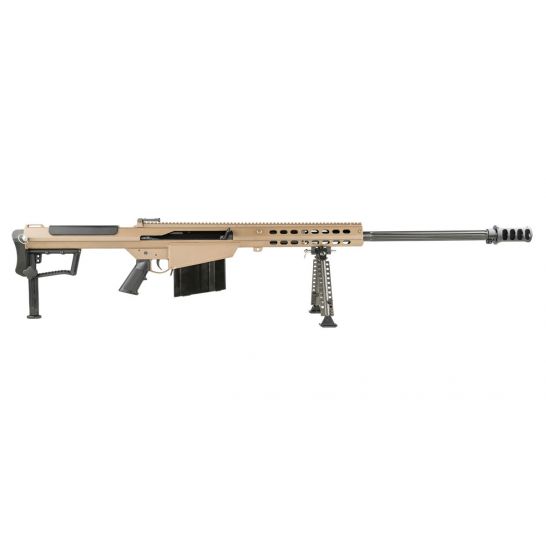
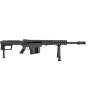
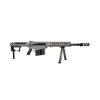
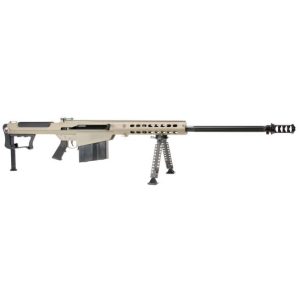
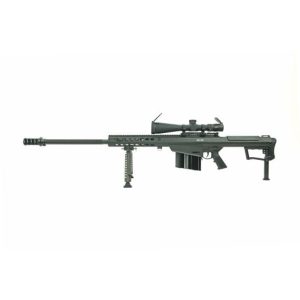
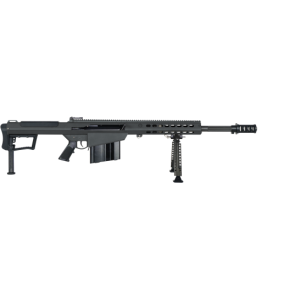
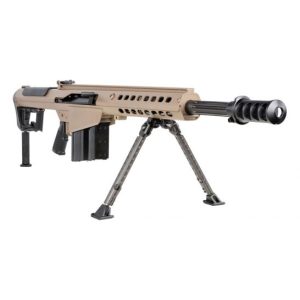
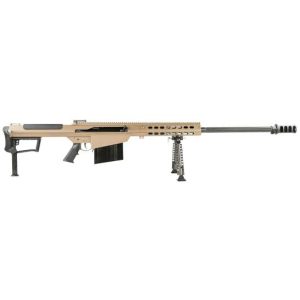
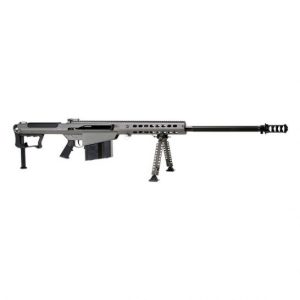
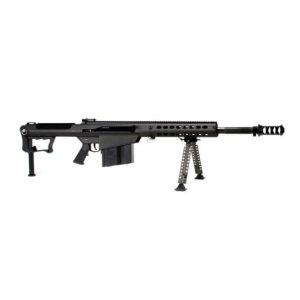
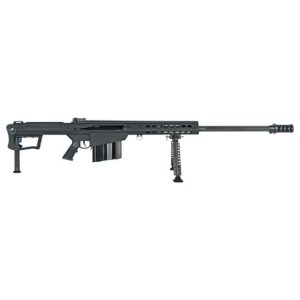
Reviews
There are no reviews yet.